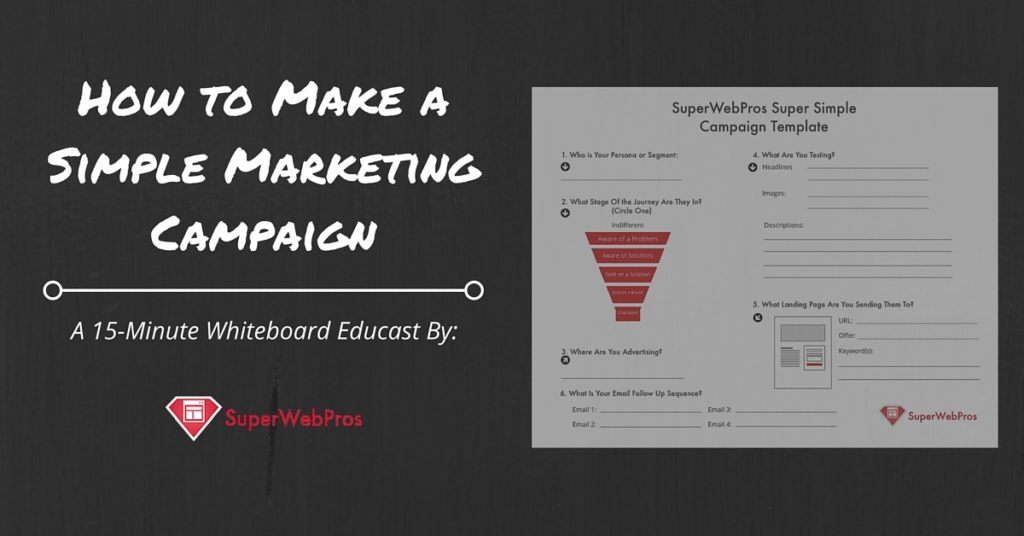Hey there!
In today’s Whiteboard Wednesday, I show you how we organize some of our Marketing Campaigns.
While this approach is specific to how we do things, I suspect that you will also pick up something that is valuable to you as you build your own campaigns.
At the very least, this video is intended to be a guide more practical than theoretical.
That said, I urge you to watch the video. But, if you don’t, here are the highlights.
(Oh, before I forget, you may want to click below to download a copy of the template that I use in this screencast.)
 First Things First
First Things First
Before we jump into how we create our campaigns, I want to talk a little bit about some of our values, as we approach campaign development. These values inform our approach and help provide a ‘gut check’ when we need it.
Let’s dive in…
Value #1. We Serve Humans
We need to remember that our campaigns are aimed at helping humans.
As businesses owners, we are good at thinking about why people should want our products, but we don’t always think about things from the perspective of those who would use them.
We want to keep our prospective customers’ problems, needs and aspirations front of mind. We always try to remember what we’re really selling isn’t a product (or service). It’s something more important.
Value #2. We Want To Be Relevant & Consistent
Humans are different.
So, we may need different ads in order to stay relevant to different groups. Not all of our efforts are relevant to everyone.
And targeting ‘everyone’ is almost always a recipe for overspend.
Ideally, if you want to drive leads through your sales funnel, you want your messaging, content, and collateral to stay consistent across those different ads.
Value #3. We Need Trackability & Testability
We need to track our prospective customer’s complete sales journey in order to understand how we’ve helped them along the journey.
This is important, both for their sake (are we relevant?) and ours (are we being economical?).
Also, there are rarely perfect solutions or obvious answers. So, we need to test our campaigns in order to improve on them and see what resonates with the humans we serve.
With those values in mind, let’s run through a sample campaign…
An Example Campaign – A Lemonade Stand
Ok, Let’s Pretend…
We are Kid. We want to open a lemonade stand.
Our campaign needs to attract more business to our stand.
The first, almost obvious question is: Who do we want to target?
- Kids?
- Adults?
- People in our subdivision?
Reasonable targets, but broad.
We want to go deeper than broad segments. We want to dive into the lives of those people we’d like to work with.
Clarity makes it easier to figure out what to say and, equally importantly, how to say it without wasting a ton of ad spend.
For our example campaign, we might want to target “Moms who live within two blocks of our lemonade stand.”
That’s a reasonable segment in our fictitious universe. It’s geographically focused (they live within walking distance), gender-specific (we’re targeting women), and says something about their stage in life (they have children – and are likely married).
But, to better serve – and communicate – to them, we’d want to know more.
We might ask:
- What do we know about them?
- Are they married?
- Do they work outside the home?
- Do they volunteer?
- What do they spend their time doing?
- Do they take their kids to the park?
- Do they jog?
- Walk the dog?
- Where do they spend their money?
- Are they eating at Culvers? Or Whole Foods?
- Do they drive Fords or Lexus?
- What do they care about?
- Are they turned off by ‘sweet’ lemonade because it’s high in sugar?
- What if it were organic?
We start asking as many questions as we can until we feel really clear that we know the person we’d like to target. This is what many would call a persona or a customer avatar.
Whatever we call them, it represents a person (value 1).
For the purposes of our example, we’ll create and name our persona “Sissy, the Stay-at-Home-Mom.”
(Still haven’t downloaded the template? Following along would be much easier if you did…)

Understand & Target Campaigns Based On The Buyer’s Journey
We’ll talk about this more in next week’s “Whiteboard Wednesday,” but before we begin a campaign, we want to know what Stage of the Journey Sissy is in.
Questions we might ask include:
- Do her kids drink lemonade? Does she let them? Why or why not?
- If they do drink lemonade, what kind?
- How open are they to switching brands?
- Is she a couponer looking for the best deal?
Understanding what’s going on in her head vis-a-vis our product is essential because we’ll create different campaigns based on which stage of the journey she’s in.
Pick A Channel, Test It, Then Optimize For It
So, we’ve decided that we want to try and Get Sissy off the Bench and to do that we want to start to make her aware of the myriad benefits associated with lemonade consumption. Not only is it replete with Vitamin C, but ours is the only kind of lemonade with a special kind of sweetener that won’t rot kids’ teeth. But they still love it.
There are lots of places where we could start to advertise that message: Facebook, Google Display Ads, the local paper, a posterboard in front of our booth.
To figure out the best place to do that, we create a hypothesis (based on our knowledge of Sissy) about where she’s likely to ‘hang out’ (in person or online) and then plant our message in front of her as best (and often) as we can.
A key point here is that campaigns should be mapped to the stage the prospective customers is in their journey. If Sissy is clipping coupons, we’d want to make sure we’re in the weekly circular, for instance.
Depending on who they are, their stage in the journey, and the channel we are using, the campaigns will be slightly different in order to convert them into a customer.
Now It’s Time To Think About An Ad
Here’s where testability really matters.
We need to make Sissy, who lives a couple blocks away, aware of the lemonade stand.
We have lots of options. We could send her a direct mailer with a coupon or offer. We could target her on Facebook. We could (gasp) go knock on her door and make her aware of our stand.
But, what messages will get her there?
Is it that lemonade is a healthy drink? Or maybe that it’s safe on teeth? Or that’s even better than Chick-Fil-A (ok, that’s a hard sell)?
Not knowing is not bad, as long as we can test.
Come Up With A Headline And Art
So, we scratch our heads and come up with a headline. And some art.
Sometimes it’s good. Othertimes it’s not as good.
But that’s why we test.
Reagardless, we try to make each ad focus on a specific pain or aspiration. Health or Teeth?
We then come up with multiple headlines and images for each, then test which combinations seem to convert, based on our goals. The clarity we gain will help us continue to resonate with customers and refine our persona.
Now, Send Her To A Landing Page.
Landing pages are different from typical site pages. They are more focused and prioritize conversion over information. We use them any time we advertise.
Maybe it’s an offer, such as a health fact sheet, that lives on a specific URL that represents your specific campaign. Or maybe it’s a coupon (if you lack originality).
Then, as you run the ad, measure how many visitors are showing up and how they’re interacting.
And Follow Up
We ask for email addresses for almost all of our offers. And aim to follow up immediately once we’ve promised something.
Finally, we typically have a few ‘nurturing’ emails to test the temperature of the prospective customer, before continuing to measure their engagement over time.
In either case, the point isn’t to immediately start selling. It’s to understand where our prospect is in the buying journey and figure out how to move her to the next point in the funnel.
Then, we rinse, wash, repeat.
If it seems like a lot of regimented work, it’s because it is.
But, it also keeps us lean and economically efficient as we grow. Which is ultimately what we’re shooting for. How about you?
(Wow. You Made it to the Bottom. Kudos. You Should Also Watch the Video. And Download this Template. You Can Print & Re-Use it To Your Heart’s Content)




